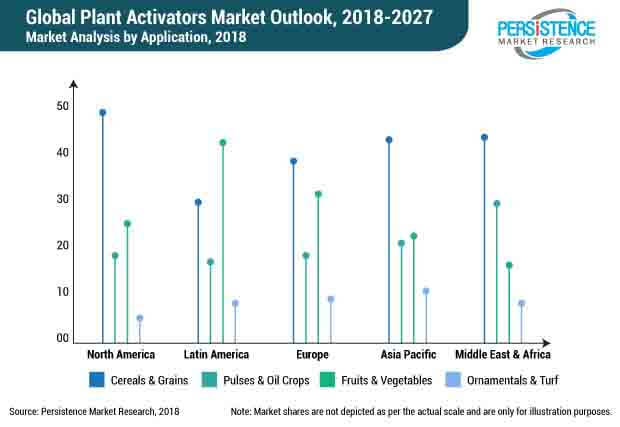Plant Activators Market Segmented By Source Biological, Synthetic Source in Liquid, Dry Form in Foliar Spray, Soil Treatment, Seed Treatment, Water Drenching
Industry: Food and Beverages
Published Date: January-2019
Format: PPT*, PDF, EXCEL
Delivery Timelines: Contact Sales
Number of Pages: 130
Report ID: PMRREP26887
The agricultural sector is rapidly changing with increasing developments across the globe. Various markets are emerging in the agricultural sector, with a dominant driver of the increasing demand for food. Decreasing resources and arable land are leading to increased pressure on the demand-supply of agricultural products, which has proved to be a factor for the emergence of new products that can increase agricultural produce.
Changing environmental status and climatic conditions, as well as the emergence of various pests and disease outbreaks have a negative impact on the yield and quality of crops. This has drastically increased the demand for crop care and protection products such as plant activators, recently.
Plant activators are chemicals that activate plant defense genes by via signal transduction. This activation of genes is essential in order to resist various biotic and abiotic stress conditions such as attacks by pests, insects, or pathogens. Plant activators directly don’t attack the pests or pathogens, but induce a self-defense mechanism in plants so that they can defend themselves against an attack.
The global plant activators market is expected to have an attractive absolute dollar opportunity of around US$ 643.8 Mn by 2027 over 2018. The fruits & vegetables segment under crops is expected to have a relatively high CAGR across all the segments in the plant activators market.
Asia Pacific is expected to be a prominent region in the global plant activators market during the forecast period, owing to larger and ever-growing agricultural activities in the region. Latin America and North America are also expected to be key regions in plant activator space over the forecast period.
By source of plant activators, the synthetic segment is expected to be a prominent segment as compared to the biological segment in terms of value over the forecast period, owing to its increasing effectiveness and multiple benefits. However, the biological segment fares better in the plant activators market in terms of volume, owing to lower prices, ease of use, and fewer hazards.
The liquid segment, by form, dominates the market as compared to the dry segment in the plant activators market, due to ease of handling, lesser hazards, and emerging technologies, as well as the increasing preference for foliar spray application.
In the global plant activators market, by application of plant activators, the foliar spray segment is expected to be a prominent segment as compared to the others, due to emerging technologies and innovation in sprayers, as well as the large application of plant activators for fruits using foliar sprays.
The fruits and vegetable segment, by crop, is a prominent segment in the plant activators market as compared to the rest of the segments, due to increasing demand, as well as the rising problem of resistant pest and disease outbreaks on fruit crops.

The increasing demand for crop care and protection products is proving to be a direct driver for the plant activators market. The increasing population, decreasing arable land, and poorer soil quality are proving to be drivers of the plant activators market, since plant activators are expected to increase long-term agricultural productivity and restore soil balance. Increasing pest attacks and the outbreaks of diseases lead to a decrease in the yield of crops.
The extensive use of chemical pesticides and fungicides is known to have adverse effects on consumers as well as deteriorate the quality of soil. As such, there is increasing demand for plant activators as an alternative to pesticides and fungicides. Plant activators act by stimulating the natural defense system of a plant, and hence, don’t actually interact with the pathogen or accumulate on the crops.
This means that they are harmless as far as the health of consumers are concerned. Evolving species of various pests and pathogens are turning resistant to traditional crop protection solutions. Plant activators are thus used widely to combat resistant pests and pathogens.
However, high manufacturing and R&D costs as well as lower awareness in emerging regions are hindering market growth.
The global plant activators market is regionally segmented into North America, Latin America, Europe, Asia Pacific, and Middle East & Africa. Regionally, Asia Pacific, North America, and Europe, currently, are prominent regions in the global plant activators market. However, Asia Pacific is expected to show rapid growth and become a comparatively prominent region in the plant activators market over the forecast period.
Large-scale agricultural activities in Asia Pacific, with the growing demand for food from India and China, along with the rising awareness among people about the long term benefits of using plant activators are some of the prime factors that are driving the plant activators market in the region.
Large and growing fruits & vegetable market in major countries, as well as emerging technological advancements, make Latin America an attractive market for plant activators. North America and Europe are expected to exhibit steady growth in the global plant activators market, since they are mature markets for food and agricultural products.
The Middle East & Africa is expected to exhibit a comparatively lower growth in the plant activators market, due to less agricultural activities in the region as compared to the other parts of the world.
With all the factors above, the global plant activator market is expected to have positive growth in terms of volume and value during the forecast period.
| Attribute | Details |
|---|---|
| by Source |
|
| by Form |
|
| by Application |
|
| by Crop |
|
| by Region |
|
To know more about delivery timeline for this report Contact Sales
